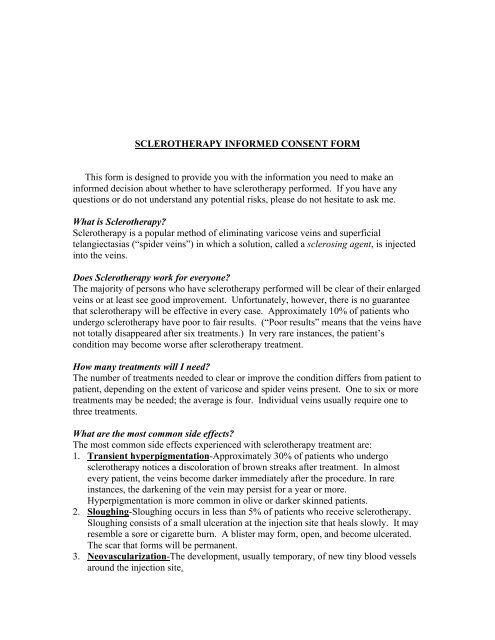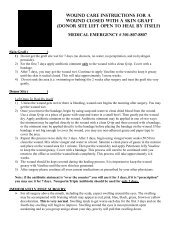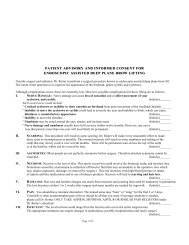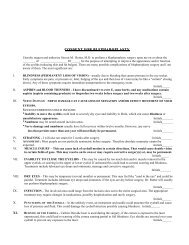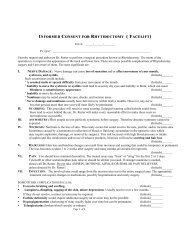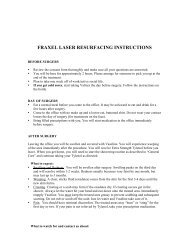SCLEROTHERAPY INFORMED CONSENT FORM This form is ...
SCLEROTHERAPY INFORMED CONSENT FORM This form is ...
SCLEROTHERAPY INFORMED CONSENT FORM This form is ...
Create successful ePaper yourself
Turn your PDF publications into a flip-book with our unique Google optimized e-Paper software.
<strong>SCLEROTHERAPY</strong> <strong>IN<strong>FORM</strong>ED</strong> <strong>CONSENT</strong> <strong>FORM</strong><br />
<strong>Th<strong>is</strong></strong> <strong>form</strong> <strong>is</strong> designed to provide you with the in<strong>form</strong>ation you need to make an<br />
in<strong>form</strong>ed dec<strong>is</strong>ion about whether to have sclerotherapy per<strong>form</strong>ed. If you have any<br />
questions or do not understand any potential r<strong>is</strong>ks, please do not hesitate to ask me.<br />
What <strong>is</strong> Sclerotherapy?<br />
Sclerotherapy <strong>is</strong> a popular method of eliminating varicose veins and superficial<br />
telangiectasias (“spider veins”) in which a solution, called a sclerosing agent, <strong>is</strong> injected<br />
into the veins.<br />
Does Sclerotherapy work for everyone?<br />
The majority of persons who have sclerotherapy per<strong>form</strong>ed will be clear of their enlarged<br />
veins or at least see good improvement. Unfortunately, however, there <strong>is</strong> no guarantee<br />
that sclerotherapy will be effective in every case. Approximately 10% of patients who<br />
undergo sclerotherapy have poor to fair results. (“Poor results” means that the veins have<br />
not totally d<strong>is</strong>appeared after six treatments.) In very rare instances, the patient’s<br />
condition may become worse after sclerotherapy treatment.<br />
How many treatments will I need?<br />
The number of treatments needed to clear or improve the condition differs from patient to<br />
patient, depending on the extent of varicose and spider veins present. One to six or more<br />
treatments may be needed; the average <strong>is</strong> four. Individual veins usually require one to<br />
three treatments.<br />
What are the most common side effects?<br />
The most common side effects experienced with sclerotherapy treatment are:<br />
1. Transient hyperpigmentation-Approximately 30% of patients who undergo<br />
sclerotherapy notices a d<strong>is</strong>coloration of brown streaks after treatment. In almost<br />
every patient, the veins become darker immediately after the procedure. In rare<br />
instances, the darkening of the vein may pers<strong>is</strong>t for a year or more.<br />
Hyperpigmentation <strong>is</strong> more common in olive or darker skinned patients.<br />
2. Sloughing-Sloughing occurs in less than 5% of patients who receive sclerotherapy.<br />
Sloughing cons<strong>is</strong>ts of a small ulceration at the injection site that heals slowly. It may<br />
resemble a sore or cigarette burn. A bl<strong>is</strong>ter may <strong>form</strong>, open, and become ulcerated.<br />
The scar that <strong>form</strong>s will be permanent.<br />
3. Neovascularization-The development, usually temporary, of new tiny blood vessels<br />
around the injection site.
4. Allergic Reactions-Very rarely, a patient may have an allergic reaction to the<br />
sclerosing agent used. The r<strong>is</strong>k of an allergic reaction <strong>is</strong> greater in patients who have<br />
a h<strong>is</strong>tory of allergies. The worst allergic reaction could result in inability to breathe<br />
and death.<br />
5. Pain-A few patients may experience moderate to severe pain and some bru<strong>is</strong>ing,<br />
usually at the injection sites. The veins may be tender to the touch after treatment,<br />
and an uncomfortable sensation may run along the vein route. The pain <strong>is</strong> usually<br />
temporary, in most cases lasting 1 to 7 days.<br />
6. Itching-Depending on the type of solution used, you may experience mild itching<br />
along the vein route. <strong>Th<strong>is</strong></strong> itching normally lasts 1 to 2 days.<br />
What are the other side effects?<br />
Other side effects include a burning sensation during injection of some solutions,<br />
neovascularization (the development-usually temporary-of new tiny blood vessels),<br />
transient phlebitic-type reactions (swelling of the vein might cause the ankles to swell),<br />
temporary superficial swellings or wheals (similar to hives), and, very rarely, wound<br />
infection, poor healing, or scarring.<br />
Phlebit<strong>is</strong> <strong>is</strong> a very rare complication, seen in approximately 1 of every 1000 patients<br />
treated for varicose veins 3 to 4 mm or greater in diameter. The dangers of phlebit<strong>is</strong><br />
include the possibility of pulmonary embolus (a blood clot to the lungs-which could be<br />
fatal) and postphlebit<strong>is</strong> syndrome, in which the blood clot <strong>is</strong> not carried out of the legs,<br />
resultant swelling of the legs.<br />
What are the possible complications if I do not have sclerotherapy?<br />
In cases of large varicose veins (greater than 3 to 4 mm in diameter), spontaneous<br />
phlebit<strong>is</strong> and/or thrombos<strong>is</strong> may occur with the associated r<strong>is</strong>k of possible pulmonary<br />
emboli. Additionally, large skin ulcerations may develop in the ankle region of patients<br />
with long-standing varicose veins with underlying venous insufficiency. Rarely these<br />
ulcers may hemorrhage or become cancerous.<br />
Are there other procedures to treat varicose veins and telangiectasias? What are their<br />
side effects?<br />
Vein stripping and/or ligation may also be used to treat large varicose veins. <strong>Th<strong>is</strong></strong><br />
generally requires a hospital stay and may be per<strong>form</strong>ed under general anesthesia. R<strong>is</strong>ks<br />
of vein stripping or ligation include permanent nerve damage and possible pulmonary<br />
emboli, infection, and permanent scarring. General anesthesia has some associated<br />
serious r<strong>is</strong>ks, including paralys<strong>is</strong>, brain damage and death.<br />
What if I experience a problem after receiving sclerotherapy?<br />
If you notice any adverse reaction, please call the office immediately.<br />
**********************************************************************<br />
By signing below, I acknowledge that I have read the foregoing in<strong>form</strong>ed consent <strong>form</strong> and that the doctor<br />
has adequately in<strong>form</strong>ed me of the r<strong>is</strong>ks of sclerotherapy treatment, alternative methods of treatment, and<br />
the r<strong>is</strong>ks of not treating my condition. I hereby request and consent to sclerotherapy treatment per<strong>form</strong>ed<br />
by Dr. Rotter.<br />
Patient’s Signature_________________________________________Date__________________


